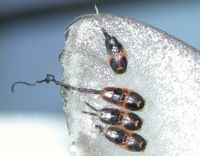Difference between revisions of "Sea Lice"
Jump to navigation
Jump to search
| Line 76: | Line 76: | ||
[[Crustacea_Flashcards_-_WikiBugs|Crustacea Flashcards]] | [[Crustacea_Flashcards_-_WikiBugs|Crustacea Flashcards]] | ||
[[Category:Crustacea]] | [[Category:Crustacea]] | ||
| − | [[Category:To_Do_- | + | [[Category:To_Do_-_CABI]] |
Revision as of 22:24, 10 July 2011
- Economic importance to the fish farming industries
- Especially in North American and in Northern Europe
- Lepeophtheirus is found only in the Northern hemisphere
- Caligus is found worldwide
Recognition
- Males measure 6mm in length
- Females measure 1cm long
- Have a long egg sac
- 5 pairs of legs
- 3 pairs for swimming
- 2 pairs modified for eating
- Brown to red in colour
- Similar in appearance to the horse shoe crab
Life Cycle
- Eggs released from long egg sacs into environment
- 2 non-parasitic larval stages
- 7 parasitic larval stages (nauplius)
- Copepod, chalimus and pre-adult
- Life cycle takes 3 weeks to 4 months depending on temperature
Epidemiology
- Largely found in salt water
- Most wild salmonids migrate to the sea for part of their life cycle
- Sealice numbers are low on wild salmonids (adults only)
- Sealice numbers are high on farmed salmonids (larvae and adults)
- 90% prevalence
- Average of 5-10 sealice upon a single fish
- Most sealice found on dorsal fin, head and back and underside of tail and fins
- Adults survive for over 3 weeks
- Migration of larval stages can be up to 1km
- Larvae locate host by responding to changes in light and vibration
Pathogenesis
- Adults and larval stages are epidermal browsers
- Mouth tube of toothed ridges abrades fish epidermis
- Heavy infections leads to:
- Epidermal abrasion
- Haemorrhage
- Immunosuppression
- Decreased productivity
- Death
Control
- Ectoparasiticides
- Hidden antigen vaccine
- Wrasse which feed on sealice
- Management improvements
- E.g. All in, all out and 6 week fallowing
- Stock selection
- e.g. Selective breeding for resistance
